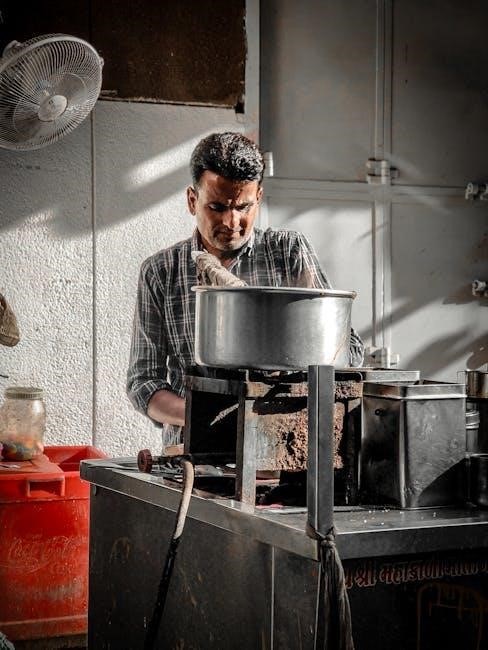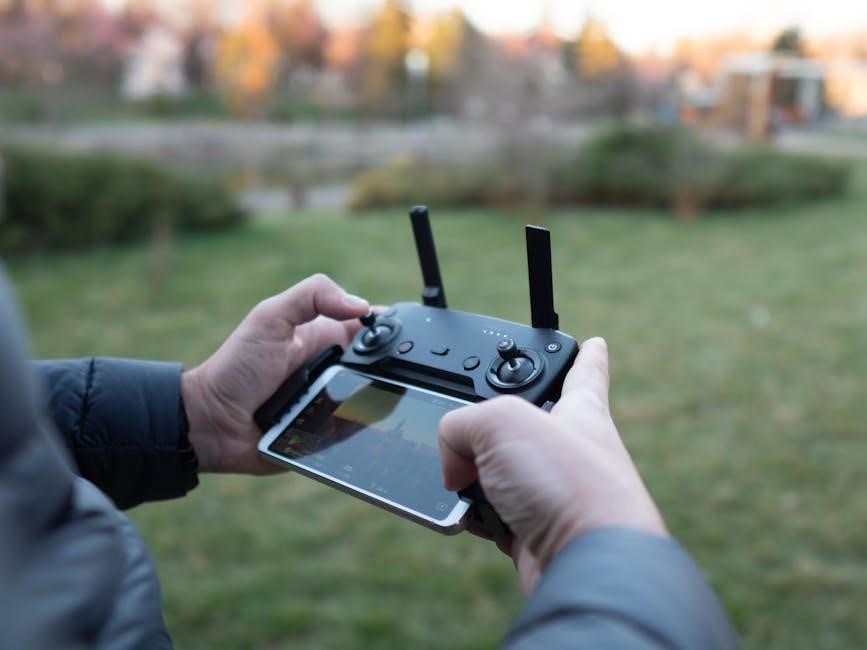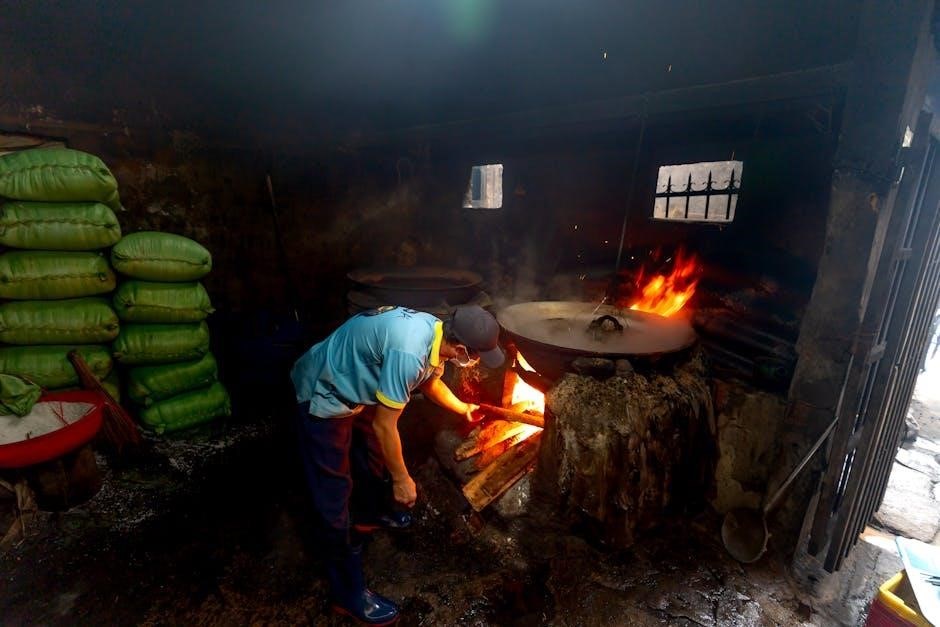Welcome to the Frigidaire Stove User Manual. This guide provides essential information for safe and effective use of your appliance, including key features and troubleshooting tips.
1.1 Importance of Reading the Manual
Reading the Frigidaire Stove User Manual is crucial for safe and efficient operation. It provides detailed safety precautions, such as avoiding empty cookware on burners and not using aluminum foil improperly. Understanding the manual ensures you grasp key features, optimal heat settings, and maintenance tips. It also guides troubleshooting common issues, like error codes or sudden malfunctions. The manual helps you optimize cooking performance and extend the appliance’s lifespan. By following the instructions, you can prevent accidents and ensure compliance with warranty terms. Familiarizing yourself with the manual empowers you to use the stove confidently and effectively, making it an essential step before cooking.
1.2 Key Features of the Frigidaire Stove
The Frigidaire Stove is equipped with advanced features designed for versatile cooking. It includes a convection oven for faster and even baking, along with multiple burners for simultaneous cooking tasks. The stove boasts digital controls for precise temperature management and a spacious oven cavity to accommodate large dishes. Additional features like quick preheat and specialized cooking modes enhance efficiency. The cooktop offers a durable surface, resistant to scratches and high heat. With both electric and gas models available, the stove caters to different user preferences. Its sleek design integrates seamlessly into modern kitchens, providing both functionality and aesthetic appeal. These features make the Frigidaire Stove a reliable choice for home cooks seeking convenience and performance.

Safety Instructions
Always read the manual before use. Avoid placing aluminum foil directly on the appliance or cooktop. Never operate with empty cookware or without proper ventilation. Ensure the stove is clean and free from debris to prevent hazards.
2.1 General Safety Precautions
Always read the manual thoroughly before using your Frigidaire stove. Ensure the appliance is installed and maintained correctly to avoid hazards. Avoid placing aluminum foil directly on the cooktop or inside the oven, as it can cause damage or fires; Never operate the stove with empty cookware, as this can lead to dangerous overheating. Keep children and pets away from the stove while it is in use. Do not store flammable materials near the appliance. Ensure proper ventilation in your kitchen to prevent the buildup of harmful fumes. Regularly clean the stove to prevent grease and food residue from causing fires. Always use oven mitts or tongs to handle hot cookware. Follow all safety guidelines to ensure safe and effective operation of your Frigidaire stove.
2.2 Electrical Safety Guidelines
Ensure your Frigidaire stove is properly connected to a grounded electrical outlet with the correct voltage rating. Avoid overloading circuits, as this can cause electrical hazards. Never use damaged or frayed power cords, and keep the area around electrical components clean and dry. If the stove malfunctions, unplug it immediately and contact a certified technician. Do not attempt DIY repairs on electrical components, as this can lead to serious injury or fire risks. Always follow the recommended power specifications in the manual to prevent electrical overload. In case of a power outage, wait for the stove to cool before restarting it. Regularly inspect electrical connections for wear or damage. Keep children away from the stove’s electrical controls to avoid accidental activation or tampering.

Installation and Setup
Ensure your Frigidaire stove is installed with the correct voltage and grounding. Follow the pre-installation checklist and ensure proper leveling and securing to prevent movement.
3;1 Pre-Installation Checklist
Before installing your Frigidaire stove, ensure the following: the installation site is level, and the floor is sturdy. Verify the electrical connection matches the stove’s requirements. Check for proper ventilation as specified. Ensure all packaging and protective materials are removed. Inspect the stove for any damage before installation. Review local building codes and regulations. Confirm the correct tools and hardware are available. Finally, ensure the installation area is clear of flammable materials and obstructions. Proper preparation ensures a safe and efficient installation process. Always follow the manufacturer’s guidelines for a secure setup.
3.2 Proper Ventilation Requirements
Proper ventilation is crucial for safe and efficient operation of your Frigidaire stove. Ensure your kitchen has adequate airflow to remove cooking fumes, moisture, and combustion byproducts. Install a range hood or exhaust fan that meets the stove’s specifications, ensuring it is ducted to the outdoors if required. Maintain a minimum distance of 12 inches between the stove and any combustible materials. Regularly clean filters and ducts to prevent grease buildup and ensure optimal performance. Always follow local building codes and the manufacturer’s recommendations for ventilation systems. Proper ventilation not only enhances cooking efficiency but also helps maintain a safe and healthy indoor environment.

Operating the Stove
Understand your stove’s controls, including ignition, burner adjustment, and oven settings. Always light burners safely and monitor cooking. Preheat the oven as instructed for even heating. Ensure proper ventilation and never leave cooking unattended. Clean spills immediately to prevent damage. Follow recipes and adjust heat settings as needed for optimal results. Refer to the manual for specific guidance on convection cooking and special features.
4.1 Cooktop Operation Basics
To operate the cooktop safely and efficiently, ensure the area is clear of flammable materials. For gas models, ignite burners by turning the knob and pressing the ignition button; Electric models heat up instantly when the knob is turned. Always use cookware with flat bottoms and compatible sizes for burners. Avoid overheating by monitoring the heat settings. Never leave cooking unattended, especially with oil or grease. Keep children away from the cooktop. Clean spills immediately to prevent damage. For gas stoves, ensure the flame is blue and adjust airflow if necessary. Refer to the manual for specific instructions on burner ignition types, such as glow bars or sparkers. Proper maintenance ensures longevity and performance. Always turn off burners when not in use.
4.2 Using the Oven Function
Before using the oven, ensure it is preheated to the desired temperature. Use the digital controls to set the temperature and select the cooking mode, such as bake, roast, or convection. Place food in the center of the oven rack for even cooking. Avoid using aluminum foil directly on the oven floor, as this can cause damage. For convection cooking, reduce the temperature by 25°F and adjust cooking time. Always use oven mitts to handle hot dishes. After cooking, allow the oven to cool before cleaning. Regularly clean food residue to maintain performance. Refer to the manual for specific guidelines on using the oven function effectively and safely.
4.3 Convection Cooking Tips
For optimal convection cooking, reduce the recipe temperature by 25°F and shorten cooking time by about 25%. Use bakeware that allows air to circulate freely. Position racks properly to ensure even cooking. Avoid overcrowding the oven, as this can reduce airflow. Always preheat the oven before starting convection mode. Use the convection fan for roasting meats, baking cookies, and cooking evenly. Clean the oven regularly to maintain convection efficiency. Refer to your manual for specific temperature and time adjustments. Proper ventilation is key to achieving the best results with convection cooking. Ensure cookware is oven-safe and suitable for high-heat cooking. Experiment with recipes to find the perfect balance for your dishes.

Maintenance and Cleaning
Regular cleaning is essential for optimal performance and safety. Wipe the cooktop with a damp cloth after use. Avoid abrasive cleaners or metal scourers. For the oven, use a gentle cleanser and avoid harsh chemicals. Leave the oven door ajar after cleaning to ensure it dries completely. Check burner caps and igniter for food residue and clean as needed. Refer to your manual for specific cleaning instructions to maintain your appliance effectively.
5.1 Cleaning the Cooktop Surface
Regular cleaning of the cooktop surface is crucial to maintain its efficiency and appearance. For ceramic or glass surfaces, use a damp cloth to wipe away spills immediately. Avoid using abrasive cleaners, bleach, or metal scourers, as they can damage the surface. For tough stains, apply a small amount of cooktop cleaner and rub gently with a non-abrasive sponge. Rinse thoroughly and dry with a clean cloth to prevent water spots. For gas stoves, remove burner caps and grates, and soak them in warm soapy water before scrubbing. Always ensure the surface is cool before cleaning to avoid burns or damage. Regular maintenance prevents grime buildup and ensures optimal performance.
5.2 Oven Maintenance Tips
Proper oven maintenance ensures consistent performance and longevity. Avoid using aluminum foil on the oven floor, as it can cause damage or create a fire hazard. Clean spills immediately, as dried food particles can harden and become difficult to remove. Use a gentle oven cleaner or a mixture of water and baking soda for stubborn stains, applying with a soft sponge or cloth to avoid scratching surfaces. Run the self-cleaning cycle if available, but ensure the room is well-ventilated. Always check racks and walls for food residue and wash racks by hand to prevent damage. Regular maintenance helps maintain even heating, prevents odors, and keeps your oven in optimal condition for years to come.

Troubleshooting Common Issues
Troubleshooting common issues begins with identifying error codes and reviewing the user manual. Power outages may disable digital controls. Check connections, ensure proper installation, and refer to specific solutions in sections 6.1-6.3 for detailed guidance.
6.1 Identifying Common Problems
Identifying common issues with your Frigidaire stove starts with understanding error codes and observing appliance behavior. Power outages may disable digital oven controls, requiring a reset. Ignition problems, such as continuous sparking, often indicate a faulty igniter or clogged burner ports. Strange noises, like rattling or clicking, could signal loose parts or malfunctioning components. If the cooktop or oven fails to heat, check electrical connections and ensure the stove is properly plugged in. Refer to the user manual for specific error code meanings and basic troubleshooting steps. Always prioritize safety by turning off the appliance before attempting repairs.
6.2 Resetting the Stove
Resetting your Frigidaire stove can resolve various issues, such as malfunctioning controls or error codes. Start by turning off the stove and unplugging it from the power source; Wait for at least 30 seconds to allow any residual power to discharge. Plug the stove back in and turn it on to see if the issue is resolved. For models with digital displays, resetting may involve pressing and holding specific buttons, as outlined in the user manual. If the problem persists, ensure all connections are secure and consult the troubleshooting section. Always prioritize safety by turning off the appliance before attempting repairs.
6.3 Error Codes and Solutions
Frigidaire stoves may display error codes like E0, E1, E2, E3, or E4, indicating specific issues. E0 often relates to a faulty temperature sensor, while E1 may signal an issue with the oven heating element. For E2, check the stove’s electrical connections, as it could indicate a power supply problem. If you see E3, it might mean a communication error between components. E4 typically points to a malfunctioning igniter or gas valve. Always refer to your manual for code-specific guidance. If problems persist, contact Frigidaire support or a certified technician for assistance. Regular maintenance and proper usage can help minimize these issues and ensure optimal performance.

Cooking Tips and Best Practices
Optimize your Frigidaire stove experience with these tips: use appropriate cookware, preheat the oven, and ensure proper ventilation. Follow guidelines for convection cooking and avoid overcrowding pans for consistent results.
7.1 Optimizing Heat Settings
Optimizing heat settings on your Frigidaire stove ensures efficient cooking. Start with medium heat for most dishes to prevent overheating. For delicate foods, use lower settings to avoid burning. When preheating the oven, allow it to reach the desired temperature before placing food inside. Adjust burner flames to fit your cookware size—small flames for simmering and larger ones for rapid boiling. Proper ventilation is key to maintaining even heat distribution. Experiment with settings to find the ideal balance for your recipes, ensuring consistent cooking results and prolonging appliance longevity. Regularly clean burners to maintain optimal heat output. Always refer to your manual for specific guidance tailored to your model.
7.2 Selecting the Right Cookware
Selecting the right cookware for your Frigidaire stove is crucial for optimal performance. Use cookware with flat, heavy bottoms for even heat distribution. Avoid aluminum foil directly on the stove or oven bottom, as it can cause damage. Choose cookware compatible with your stove’s heat sources—gas, electric, or induction. For gas stoves, ensure pots and pans fit securely on burners to prevent flame exposure. In the oven, use dishes rated for high temperatures to avoid cracking. Stainless steel, cast iron, and oven-safe glassware are excellent choices. Proper cookware selection enhances cooking efficiency, prevents damage, and ensures safety. Always refer to your manual for specific recommendations tailored to your Frigidaire model.

7.3 Avoiding Common Cooking Mistakes
Avoiding common cooking mistakes ensures a safer and more efficient cooking experience with your Frigidaire stove. Never activate cooking zones without cookware, as this can damage the appliance. Avoid placing aluminum foil directly on the stove or oven bottom, as it may cause damage or create hazards. Always use cookware compatible with your stove’s heat sources, such as gas, electric, or induction. Overcrowding pans can lead to uneven cooking, so ensure adequate space for even heat distribution. Preheat the oven properly before cooking to achieve consistent results. Lastly, avoid using damaged or warped cookware, as it may not heat evenly. By following these guidelines, you can prevent common issues and enhance your cooking experience.

Additional Resources
Access the full user manual online for detailed instructions. Register your product and buy genuine parts. Contact Frigidaire’s customer support for assistance and inquiries.
8.1 Accessing the Full User Manual
To access the full user manual for your Frigidaire stove, visit the official Frigidaire website. Use the search feature to locate your specific model. Download the PDF version for easy reference.
Ensure you have the model number handy, found on the product label or packaging. This manual provides detailed instructions, safety guidelines, and troubleshooting tips.

For convenience, save the manual to your device or print it. Regularly refer to it for optimal appliance performance and maintenance.
8.2 Frigidaire Customer Support
Frigidaire offers comprehensive customer support to assist with any questions or issues regarding your stove. Visit their official website to access support resources, including FAQs, repair services, and contact information.
For direct assistance, call the Frigidaire customer service hotline or use the live chat feature on their website. Ensure to have your appliance’s model number and serial number ready for faster support.
Additionally, Frigidaire provides options to register your product, purchase genuine parts, and find authorized service providers. This ensures you receive reliable and official support tailored to your stove’s needs.
Before reaching out, review the user manual or troubleshooting section to identify common issues. This can help you resolve minor problems independently or provide detailed information to support agents;